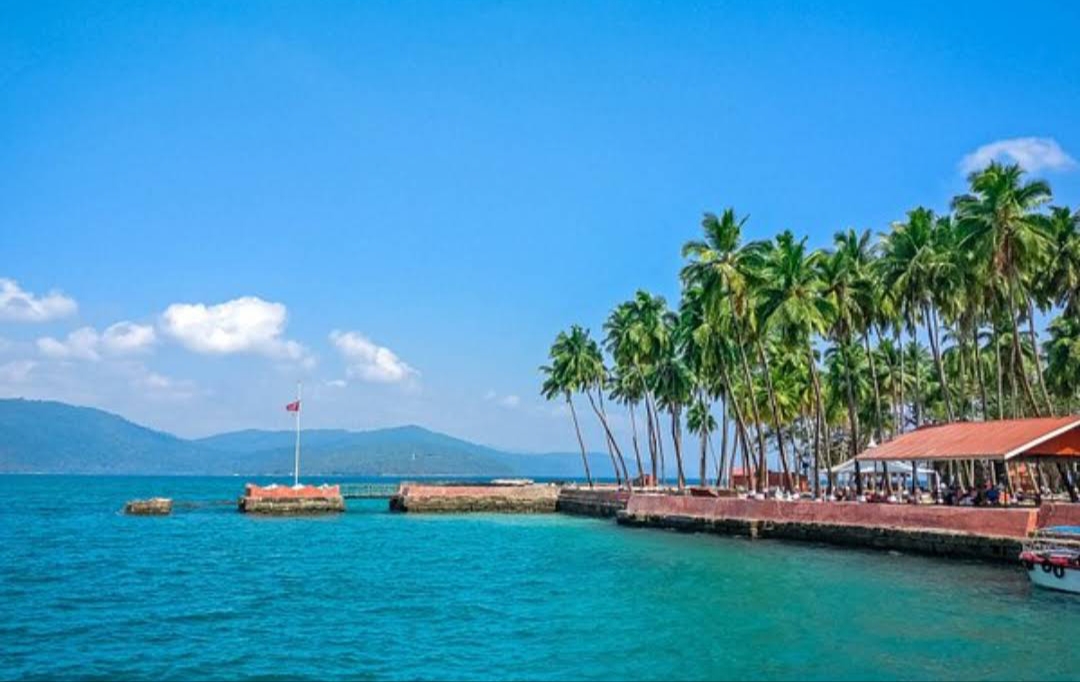
Ross Island
Exploring the Mystique of Ross Island

A Glimpse into History >
Ross Island, located near Port Blair, was once the administrative headquarters of the British in the Andaman Islands. The island, named after British marine surveyor Sir Daniel Ross, was established in 1858 following the Sepoy Mutiny in India. The British saw the strategic importance of the Andaman Islands and decided to develop Ross Island into a bustling administrative center.
During its heyday, Ross Island was known as the "Paris of the East." It was a self-sustained township with everything that the British colonials needed to feel at home. The island boasted luxurious bungalows, churches, a bakery, a printing press, a hospital, and even a swimming pool. It was a place of grandeur, where the British officials and their families lived in comfort, far removed from the harsh realities of colonial rule in the rest of India.
However, the island's glory days were short-lived. In 1942, during World War II, Japanese forces occupied the island and left their mark, which included bunkers and tunnels that can still be seen today. The Japanese occupation, followed by a devastating earthquake in 1941, led to the decline of Ross Island. The British never fully restored it, and it was eventually abandoned, leaving nature to reclaim the island.
A Walk Through Ruins and Remembrance
Today, Ross Island is a shadow of its former self, with ruins that speak volumes about its historical significance. The island, now managed by the Indian Navy, is open to tourists who come to explore the remnants of the past. As you step onto the island, you are greeted by the remnants of old colonial buildings, their walls covered in vines and roots, creating an eerie yet captivating atmosphere.
One of the most notable structures on the island is the Presbyterian Church, which still stands tall despite the passage of time. The church, once a place of worship for the British, is now a skeletal structure, with its roof gone and walls crumbling, but it retains an air of solemnity that resonates with visitors.
Another significant site on the island is the Chief Commissioner's Bungalow. This grand building, which once housed the British administrator, is now a ruin overrun by banyan trees. The sight of these massive trees enveloping the structure is a powerful reminder of nature's ability to reclaim what was once hers.
The island also houses a small museum maintained by the Indian Navy, where visitors can learn more about the island's history and the people who once lived there. The museum offers photographs, old documents, and artifacts that provide a deeper understanding of the island's past.
Nature’s Revival
Despite its tumultuous history, Ross Island is not just about ruins and memories. The island is a thriving example of nature's resilience. The once-abandoned island is now home to a variety of flora and fauna. The island's dense vegetation is a stark contrast to its colonial past, with tall coconut palms, indigenous shrubs, and blooming flowers painting a picture of natural beauty.
Deer, peacocks, and rabbits roam freely on the island, adding to its charm. These animals, introduced during the British era, have adapted to the island's environment and are now an integral part of its ecosystem. The island is also a bird-watcher's paradise, with several species of birds making it their home.
The surrounding waters of the island are equally captivating. The crystal-clear waters of the Andaman Sea offer opportunities for snorkeling and diving, where one can explore vibrant coral reefs and diverse marine life. The island's beaches, though not ideal for sunbathing due to their rocky nature, provide stunning views of the ocean and the neighboring islands.
Ross Island in Popular Culture
Ross Island's rich history and natural beauty have not gone unnoticed in popular culture. The island has been featured in several documentaries and travel shows, highlighting its unique blend of history and nature. The island's haunting ruins and scenic landscapes make it a favorite subject for photographers and filmmakers alike.
One of the most famous cultural references to Ross Island is its mention in the works of Indian author Amitav Ghosh. In his novel "The Glass Palace," Ghosh vividly describes the island's historical significance and its role during the British colonial period.
A Symbol of Resilience and Transformation
Ross Island is more than just a tourist destination; it is a symbol of resilience and transformation. It stands as a reminder of the past, a witness to the passage of time, and a testament to nature's ability to reclaim and heal. The island's history, intertwined with its natural beauty, offers a unique experience for visitors.
As you explore Ross Island, you can't help but feel a sense of connection to the past. The ruins, the natural surroundings, and the stories of those who once lived there create a tapestry of history and nature that is both intriguing and humbling.
In conclusion, Ross Island is a place where history and nature come together to tell a story of grandeur, decline, and revival. It is a journey through time, offering a glimpse into the colonial past and the resilience of nature. Whether you are a history buff, a nature lover, or simply someone seeking a tranquil escape, Ross Island has something to offer. As you walk through its ruins and forests, you will find yourself transported to another era, where the echoes of the past mingle with the whispers of the present, creating an experience that is truly unforgettable.